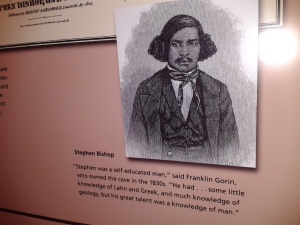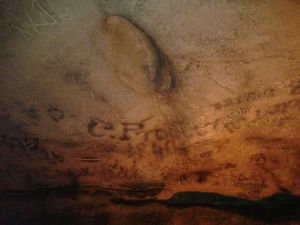Inspiration from the “Grand, Gloomy, and Peculiar”: the Story of Stephen Bishop

 More information:
–While Wikipedia is not normally considered to be a definitive source, I found this entry to be very straightforward and educational: http://en.wikipedia.org/wiki/Stephen_Bishop_%28cave_explorer%29
–There were other slaves and African Americans that worked in the cave as well (including those that ran the saltpeter mining to supply ammunition for the War of 1812): http://www.nps.gov/maca/historyculture/black-history.htm
–Stephen Bishop’s Grave: http://www.findagrave.com/cgi-bin/fg.cgi?page=gr&GRid=10041751
–General information on Mammoth Cave National Park: http://www.nps.gov/maca/index.htm
More information:
–While Wikipedia is not normally considered to be a definitive source, I found this entry to be very straightforward and educational: http://en.wikipedia.org/wiki/Stephen_Bishop_%28cave_explorer%29
–There were other slaves and African Americans that worked in the cave as well (including those that ran the saltpeter mining to supply ammunition for the War of 1812): http://www.nps.gov/maca/historyculture/black-history.htm
–Stephen Bishop’s Grave: http://www.findagrave.com/cgi-bin/fg.cgi?page=gr&GRid=10041751
–General information on Mammoth Cave National Park: http://www.nps.gov/maca/index.htm
June 21, 2013, 1:30 pm
Filed under: Uncategorized | Tags: african american, caves, Charyl, history, kentucky, mammoth cave, national park, slaves, stephen bishop, tours
In keeping with the spirit of adventure, I recently decided to drive a few hours south to spend the day at Mammoth Cave National Park in Kentucky–the largest cave system in the world. I have a great fondness for caves; it’s hard to say why. There’s something magical about the quiet, dark underground. The cool air mixed with the scent of the musty deep earth brings a sense of grounding and peace. I know I’m not the only one. As mankind has been drawn to them for ages, each cave invariably holds its own history (both geologic and human)–preserved deep below the surface. This gives caves a fascination unique to anything else in our world.
Mammoth Cave does not disappoint in any of these aspects. It offers inexpensive exploration and adventure for all levels of cave and geology buffs, history lovers, and nature enthusiasts. The caves are breath-taking and the guides rustically charming. But it was the unexpected inspiration I gained from the depths of that “grand, gloomy, and peculiar” place that truly surprised me.
Gathering us in a large chamber deep below the surface, our tour guide recalled the story of a man named Stephen Bishop. In 1838, Stephen was a 17-year-old slave bought by the cave’s owners to serve as a guide, giving tours of the passages to the adventurous elite. Imagine for a moment, being a young man (born into slavery) and being taken from your family and everything familiar to a place in the woods where your masters have told you that you must go far into the dark earth with nothing but the light of a tiny oil lantern; spending all day, everyday leading strangers through the winding passages of a cave without the benefit of pay. For the most part, the passages in Mammoth Cave are not easy walk-throughs (even with today’s modern pathways and staircases). Boulders litter the paths, odd critters hide in nooks, pools of water and deep pits are strewn here and there, large passages turn into tight squeezes in which one must crawl, duck, climb, and maneuver. In Stephen’s day, going through this largely-unexplored cave must have been even more dangerous and intimidating. It would be very easy for one to get lost or injured in the complete darkness and isolation–never to return to the surface (and in fact, some have–dating all the way back to the prehistoric Native Americans in the area).
Not only did Stephen lead the tours through the risky environment of the known pathways, he is credited with discovering and mapping several miles of unexplored areas in the cave (including a dizzying landmark called “The Bottomless Pit”–which the modern day caving enthusiast can see on today’s tours). He came to love the cave–considering it his personal domain; and preferred exploration in the underworld, than the unfair treatment he received in society above-ground as a slave.
In and of itself, his story to that point is amazing; but what he continued to do is what stirs the deep wellspring of inspiration. As a slave, Stephen was not paid for his services; however he was allowed to keep tips from the sympathetic tourists he guided. He also noticed that people enjoyed leaving their mark on the cave by writing their names, dates, and hometowns on the rocky, limestone walls. Stephen decided to sell implements to his guests so that they could write, carve, or burn their information and leave their mark on history. Those writings are preserved inside the cave and can still be seen today. Over the years, Stephen taught himself to read and write from the markings the tourists left behind; astonishingly he learned to become literate not only in English, but a few other languages as well, as many of his charges were scientists and explorers from other lands. Eventually Stephen saved up enough money from his tours that he was able to buy his freedom (and that of his family’s), and buy several acres of farmland.
While Stephen never became a wealthy man, I find his story to be greatly inspiring. Here was a man in the lowliest of status and circumstance. He was forced into what, at first, seemed to be a frightening, difficult, and dangerous position. Yet over the years he not only found passion in it–but it became his best (and maybe only) way possible to gain some education, contribute to history (via his discoveries underground), and be put in a position where he and his family could eventually be free to live their own lives.
It is a story that reminds me that while at times it may seem life and God have closed all doors, leaving one in what seems like an impossibly bad situation–an opening can still be found in the most unlikeliest of circumstances; and what sometimes at first appears to be a horrible turn of events pulling a person off their path, may actually be what leads them to a greater destiny.
Filed under: Uncategorized | Tags: african american, caves, Charyl, history, kentucky, mammoth cave, national park, slaves, stephen bishop, tours

 More information:
–While Wikipedia is not normally considered to be a definitive source, I found this entry to be very straightforward and educational: http://en.wikipedia.org/wiki/Stephen_Bishop_%28cave_explorer%29
–There were other slaves and African Americans that worked in the cave as well (including those that ran the saltpeter mining to supply ammunition for the War of 1812): http://www.nps.gov/maca/historyculture/black-history.htm
–Stephen Bishop’s Grave: http://www.findagrave.com/cgi-bin/fg.cgi?page=gr&GRid=10041751
–General information on Mammoth Cave National Park: http://www.nps.gov/maca/index.htm
More information:
–While Wikipedia is not normally considered to be a definitive source, I found this entry to be very straightforward and educational: http://en.wikipedia.org/wiki/Stephen_Bishop_%28cave_explorer%29
–There were other slaves and African Americans that worked in the cave as well (including those that ran the saltpeter mining to supply ammunition for the War of 1812): http://www.nps.gov/maca/historyculture/black-history.htm
–Stephen Bishop’s Grave: http://www.findagrave.com/cgi-bin/fg.cgi?page=gr&GRid=10041751
–General information on Mammoth Cave National Park: http://www.nps.gov/maca/index.htm
Leave a comment